The Poor Little Bird is a freeware Japanese visual novel, described by its original author as a digital picture book, which was created by Eno Yamamoto Ten and first released in Japan as Kawaisou na Kotori on May 5, 2002. It was officially translated into English by the Insani translation circle and released in English on October 15, 2005, as part of the 2005 al|together translation festival. I am currently in the process of reviewing nearly freeware visual novels translated into English for the 2005, 2006, and 2008 al|together translation festivals. The Poor Little Bird was my first review of the series.
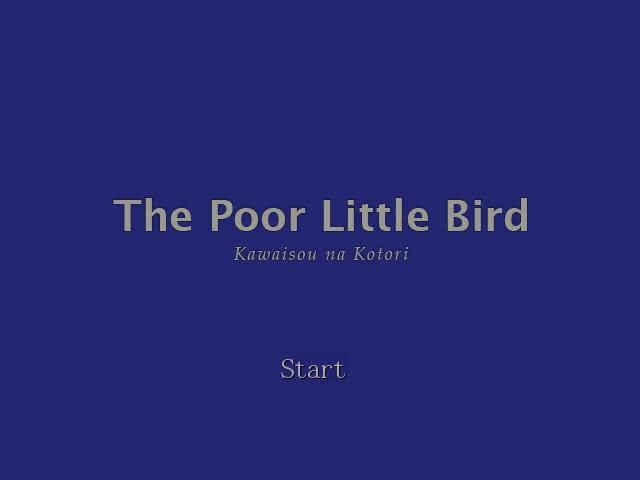
The Poor Little Bird takes about 10 minutes to read from start to finish, give or take a couple of minutes based on one’s reading speed. The creator’s decision to describe it as a digital picture book is apt — it fits the description more than any of the al|together reviews. The Poor Little Bird is something of a fairy tale, or cautionary moral tale, in sound novel form.
You can learn more about my al|together project by reading my project introduction article. That article includes a running list of our completed al|together reviews. I have a dedicated collection post with links to all of our al|together articles, including reviews, essays, and short posts.
Updates and Revisions
I made substantial updates to this post on November 25, 2022. These updates include stylistic revisions, updated information about running The Poor Little Bird based on things that I learned well after writing my initial review, improved screenshots which cut out window borders, and minor structural changes to ensure that people can easily read the full review without stumbling into my analysis section, which discusses events of the short story. However, my impressions and analysis of The Poor Little Bird are generally unchanged from the original May 6, 2021 publication.
I made several technical revisions to the post on May 30, 2023, to standardize its format with other al|together reviews.
Why The Poor Little Bird is Our First Al|Together Review
I decided to lead this review project with The Poor Little Bird for two reasons. Firstly, because the visual novel was originally made available in Japan on May 6, 2002, I wanted to release the review to mark its 19th birthday. Secondly, I have written extensively about children’s bird literature here at The New Leaf Journal. For example, see my series on an 1897 bird magazine, articles on lost birds, and discussion of several bird stories and poems from another nineteenth century children’s magazine.
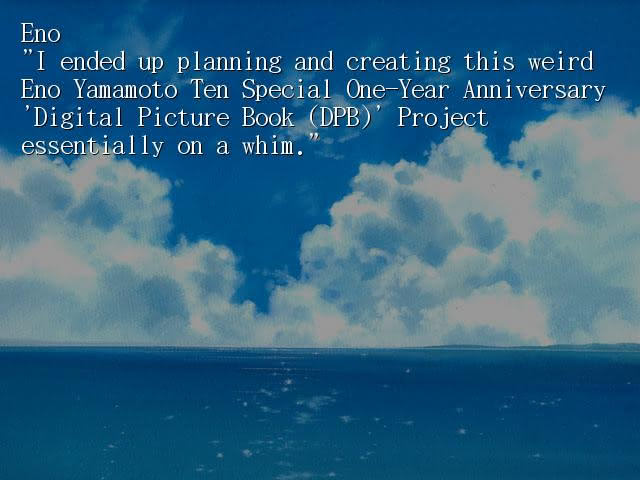
Because The Poor Little Bird is a picture book in visual/sound novel form, it fits in nicely with some of my other bird projects.
A Note on “Spoilers”
This review has two halves. The first half is a generally spoiler-free review of The Poor Little Bird. You will learn what The Poor Little Bird is, how to run it, and how it is structured without having key plot points spoiled. The second half is my analysis of The Poor Little Bird. The analysis section will discuss the actual plot in detail, and thus contains all of the spoilers.
In subsequent projects wherein I wrote an analysis of a visual novel story, I separated the review from the analysis. See e.g., From the Bottom of the Heart (review; analysis) and Shooting Star Hill (review; analysis). I should have done that for The Poor Little Bird as well, but I am not inclined to split this into two articles after the fact. However, in November 2022, I made a few revisions to more clearly separate the non-spoiler review from the analysis section.
The Poor Little Bird is very short and relatively easy to run without difficulty on Windows, Linux, MacOS, and BSD. Thus, while I only offer a qualified recommendation for The Poor Little Bird in a vacuum, I would recommend actually downloading and reading it if you were already interested enough to read the review (I will venture it does not take much longer to read the story than my review). The spoiler-free review section is for everyone (including people who do not ultimately read the story), but the analysis is intended for people who read The Poor Little Bird and are curious about seeing a second perspective on the story (the translator offers a short take in the postscript).
The Poor Little Bird Details
See Visual Novel Database Entry.
English Release
| Title | The Poor Little Bird |
| Translator | Edward Keyes (Insani) |
| Release Date | October 15, 2010 |
| Engine | ONScripter-EN |
| Official Website | Insani; al|together 2005 |
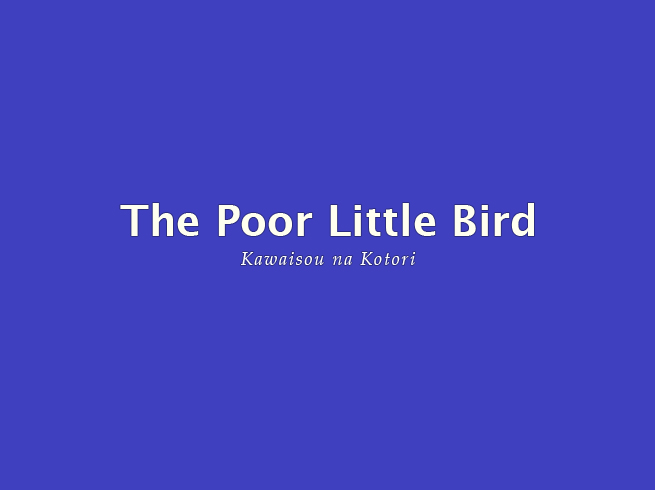
Original Japanese Release
| Title | Kawaisou na Kotori |
| Developer | Eno Yamamoto Ten |
| Music | keNji |
| Release Date | May 6, 2002 |
| Engine | NScripter |
Downloading and Running The Poor Little Bird
Download Links
- Official torrents from Insani (Windows, Linux, and MacOS)
- Official torrents from al|together 2005 (Windows, Linux, and MacOS)
- Direct download from Kaisernet (Windows — but see installation notes)
There are no official direct download links for The Poor Little Bird. Instead, the official links are all torrents. If you are willing and able, you may consider seeding the torrents to help make it easier for other people who come across The Poor Little Bird to enjoy the story.
Kaisernet, the best extant English-language resource on ONScripter visual novels (The Poor Little Bird is written in ONScripter), has a direct download link for the Windows .exe for The Poor Little Bird, which it initially mirrored from the official sources. This is the easiest way to download The Poor Little Bird and, as of this writing, works without issue.
(Some users have also uploaded The Poor Little Bird to MEGA, but for people unable or unwilling to try the official torrents, I recommend using the Kaisernet link so long as it is still working.)
The Windows version of The Poor Little Bird is the most readily available. It is possible to use the Windows .exe to run The Poor Little Bird cross-platform.
Running The Poor Little Bird
The Poor Little Bird is relatively easy to run. I have tested the Windows version under WINE on Linux and it worked with no issue or fiddling. After my initial review, I learned how to extract the contents of an ONScripter .exe file for Windows and run it natively on Linux. I explained that process here for Linux users who would prefer to run The Poor Little Bird natively instead of through WINE.
My initial review of The Poor Little Bird was based on the Windows version running under WINE, but my revisions (including new screenshots) were based on running the game natively on Linux.
General Overview
Before launching into my spoiler-free review and subsequent analysis, I offer a short introduction to what The Poor Little Bird is and its general plot. I clipped the following screenshot from its official page on the al|together 2005 website:
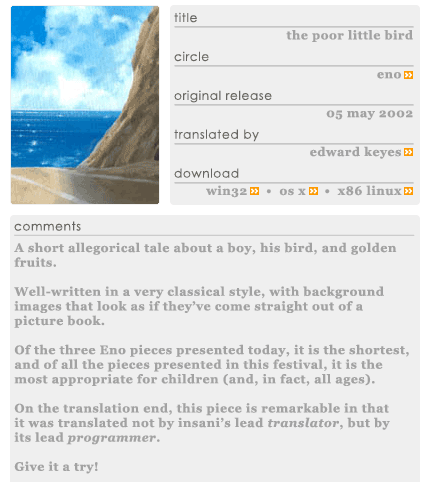
Describing The Poor Little Bird as “[a] short allegorical tale about a boy, his bird, and golden fruits” is apt. The entire story is told from the perspective of a pet bird who was much loved by the boy who owned him. The boy died, but all the bird understood was that the boy who had been there before was no longer there. In response to this sad event, the bird set off on a journey to become a boy so that he could meet the boy he loved once again. The bird persisted in this journey even when he was told that it was hopeless. The story and its themes fit very well within the digital picture book framework.
I will note that I did have some issues with the story, but I will review those in spoiler-free and spoiler-full manners in my review and analysis sections.
The Poor Little Bird Review (Spoiler-free)
In the following subsections, I will offer a complete and spoiler-free review of The Poor Little Bird for people who are interested in the game or visual novels generally.
“Game-Play”
I put “game-play” in quotation marks because The Poor Little Bird does not have any in a traditional sense. I have reviewed visual novels here at The New Leaf Journal such as Bad End which invite player input. The Poor Little Bird only invites the player to advance the text. In effect, the player turns the pages in a digital book.
There is one exception to the no-input generalization. After finishing the story, the player is offered the choice to read the epilogue, with statements from Eno and Mr. Edward Keyes.
The statements are short and worth reading, especially if you enjoyed the story. However, there are no choices in the game proper.
Options
The Poor Little Bird has a very minimalist title page and start menu. There is only one option: “Start.” No configuration options, much less additional content.
However, by right clicking anywhere in the game window, or the equivalent the player’s device, the player summons a menu with the following options:
- Auto mode
- Clear window
- Save
- History
- Return to title
I will discuss the behavior of each of these options below, with the exception of the obvious “Return to title” option.
Auto Mode
When I first saw “Auto Mode,” I assumed that it would advance the text without player input. As it turns out, Auto Mode skips over text that the player has already read. The player can break out of Auto Mode by right clicking.
Clear Window
In The Poor Little Bird, text is displayed over the entire background in a manner characteristic of many NScripter/ONScripter projects. That is, while many visual novels have a text box – a specific section of the screen where text appears – text runs down the entirety of the screen in The Poor Little Bird. By toggling on Clear Window, the player can view the background without the text. Toggling the option back off causes the text to re-appear.
The Clear Window functionality is welcome, but the story (counting the developer and translator notes at the end) only has six backgrounds and no character sprites. Furthermore, all of the backgrounds are available as jpg images in the game’s data directory, making them easily accessible.
Save
The Poor Little Bird comes with nine save slots. Save slots are always welcome, but given the fact that The Poor Little Bird is extremely short and contains no choices, I doubt that most readers will have any reason to make use of the bookmark functionality.
History
History is the most useful of the menu options. By toggling History on, the player can cycle through text that he or she read before, but which is no longer displayed on screen. For players using a mouse, this can also be triggered with the scroll wheel. Text that has already been read is rendered in yellow instead of white.
Visuals and Audio
The Poor Little Bird has all of the distinct visual hallmarks of an early 2000s NScripter/ONScripter project. While it is simple, I did enjoy its fully drawn backgrounds, which gave the story a distinct picture book charm. My impression of the soundtrack was similarly positive.
Text
The text is white and rendered in a simple but easy-to-read serif font. While the font is not the optimal choice for a visual novel, The Poor Little Bird puts a very thin dark filter over the backgrounds during game-play which makes the font pop. I could see some readers potentially having issues with a couple of scenes where the font overlays a blue sky, but I think that it was handled well.
Backgrounds
The story (and epilogue) uses seven backgrounds in total. One is a simple black background, and later in the game there is one scene with a simple yellow background. The other backgrounds are illustrated. There is an alleyway in a city or town, a cave entrance, mountain on the beach, forest, sakura tree, and the sky over the ocean.
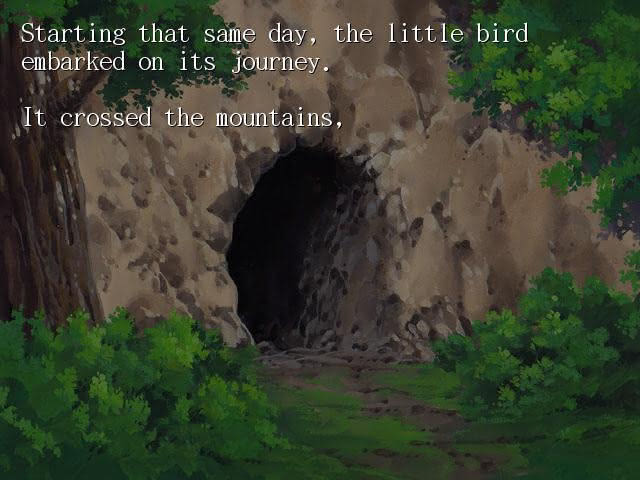
The backgrounds are all clean and well-illustrated and serve the idea of The Poor Little Bird being a digital picture book well. While there is only a small number of backgrounds, I think they offer good variety for a story that is amenable to being read in 10 minutes.
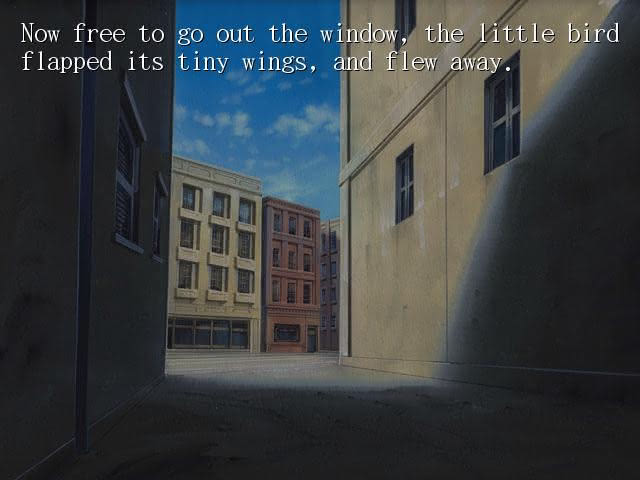
The alleyway and the sakura tree background are the two standouts from the bunch. JPG images for all the backgrounds are available in the game’s file after install. The images from the data file offer the best depictions of the backgrounds because they do not have the slight filter seen in game-play to make the text readable.
The Poor Little Bird does not have any character sprites.
Background Music
The Poor Little Bird has five background music tracks. Four of the tracks are used in the story proper and one of the tracks is used for the afterword from the author and translator. While none of the tracks are particularly memorable, they were all solid and complemented the mood of the story.
The shortest track is 1:04 and the longest is 3:45. If the player leaves the story on one track for long enough, the track will loop and start from the beginning. If one is reading reasonably quickly, he or she may make it through the story without noticing any loops.
Like the background images, the tracks are all available as individual sound files in the game’s data. “Aeta,” the longest of the tracks, is the best of the bunch.
Translation Quality
From the outset, I note that I can neither read nor speak Japanese. Thus, I am not reviewing how faithful the translation is to the original Japanese, but instead how the translation reads in English.

The translation reads very well. I did not notice any examples of awkward or clunky phrasing, much less typos. While I cannot speak for the original Japanese, nothing in the translation stood out at me as appearing to obviously deviate from how it would have read in its original form. The English product of Insani’s work compares favorably to the English-products of some professionally translated commercial games, such as one that I reviewed here at The New Leaf Journal – Bad End.
The directory for The Poor Little Bird includes a text file titled 0.txt. ONScripter games rely on the 0.txt file to run, and thus changing it is not advisable unless one understands how it works. The 0.txt file of The Poor Little Bird is worth reading, however, not necessarily to understand how the game runs, but for its notes. In addition to having the dialogue which is actually used in the end product, the 0.txt file includes comments (which are coded in such a manner that they are ignored by ONScripter when the game is running) on the translation. See an example:
;或る所に病弱な少年がいました
;aru tokoro ni pyoujakuna shounen ga imashita.
;“aru tokoro ni” is technically “at a certain place”, but is really more of a generic story opening.
`Once upon a time, there was a boy who had a weak constitution.
The Poor Little Bird is not the only al|together ONScripter translation to include comments in the translation file, but most of the games that I have looked at do not. It is a nice touch for people who are curious about the translation process or are otherwise interested in learning Japanese.
Writing and Story Quality
This is my spoiler-free story review of the writing of The Poor Little Bird.
The Poor Little Bird makes little secret of the fact that, much like the famous Key visual novels, it is on a mission to tug at the reader’s heart strings. The protagonist, The Poor Little Bird, has a bit of a misunderstanding about why his beloved owner disappeared. This misunderstanding sets the bird off on a journey. One can venture from the title of the story that this journey is full of hardships.
The Poor Little Bird is charming in its own way, and is definitely a picture book in visual novel form. I was able to enjoy it for what it is, but the story shows cracks under scrutiny. The events are set in motion by the bird’s misunderstanding. It does make clear that the bird is not entirely amenable to listening to reason, but that ultimately does not manifest as a point of emphasis in the story’s conclusion. One difficulty I personally had (your mileage may vary) was how the story ultimately weighed in on and resolved issues pertaining to the poor little bird’s wish. The wish, and the bird’s journey in pursuit of that wish, were both based on misconceptions. In light of the fact that The Poor Little Bird is a picture book and something of a moral story, there is an aspect of these misconceptions that I wished the novel explored more in its conclusion. However, I will reserve specifics for my actual analysis section.
Spoiler-free review and assessment
Eno, the creator of The Poor Little Bird, wrote in the afterword:
If you felt touched at all by this work, then I am very, very honored.
Eno
The Poor Little Bird is a project with heart (much like Plain Song, another one of Eno’s works in the al|together 2005 set), and I ultimately found it enjoyable. While it is very much of an NScripter/ONScripter visual novel of the era, the aesthetic backgrounds and original music give it individual character. It succeeded in being a digital picture book, which helps it stand out from the crowd despite its short length and otherwise typical presentation. I did have issues with the story, which I will detail below, but granting some of those flaws, I will honor Eno by noting that it was a little bit touching.
I give The Poor Little Bird a qualified recommendation for the general reader. I had issues with how it used a misunderstanding to drive its plot, but ultimately declined to address the moral of the misunderstanding in its conclusion (one could argue that it did in one way, but in so doing, I would argue that it missed the forest through the trees). The author focused on delivering an emotional punch, but he made some sacrifices with respect to the quality of the story. The Poor Little Bird is a unique little project, but it lacks the clear message that the better visual novels of this short format deliver, such as From the Bottom of the Heart.
With my caveats noted, The Poor Little Bird is a decent first step into visual novels for people who are not familiar with the format due to its accessible subject-matter and the fact that it only takes a few minutes to read. I would recommend it without any qualifications for people who are interested in visual novels generally or in the types of visual novels translated in the al|together festivals specifically. Despite its faults, The Poor Little Bird is an interesting project in its presentation and it leaves the reader with something to think about.
The Story of The Poor Little Bird (Spoilers)
Going forward, I will discuss the story of The Poor Little Bird in some detail. If you are interested in reading the story once without knowing what happens, consider this your invitation to bookmark my review to finish later.
Story Synopsis
The protagonist of the story, a little bird, lives with a sickly young boy. One day, the bird wakes up in his cage to find that the boy is not in his room. Unbeknownst to the poor little bird, his companion had passed away. An adult in the house remarks how sad this must be for the bird and decides to set the bird free.
(Note: Please do not set domestic pet birds free.)
Searching for the Boy in Vain
The poor little bird still does not understand what happened. The bird imagines that the boy must have abandoned him for some reason.
Despite believing that he had been abandoned, the poor little bird wished to see the boy again and asked why the boy had abandoned him. The bird searched in vain for the deceased boy. People in the house called out to it and suggested that had the bird been a human being, it would have been the boy’s best friend.
The Wish to Become Human
Although the poor little bird did not understand that the boy it loved was dead, it did pick up on the boy’s relatives wishing that it had been a person. The poor little bird combined these two points and convinced itself that were it to become human, the boy would see it again.
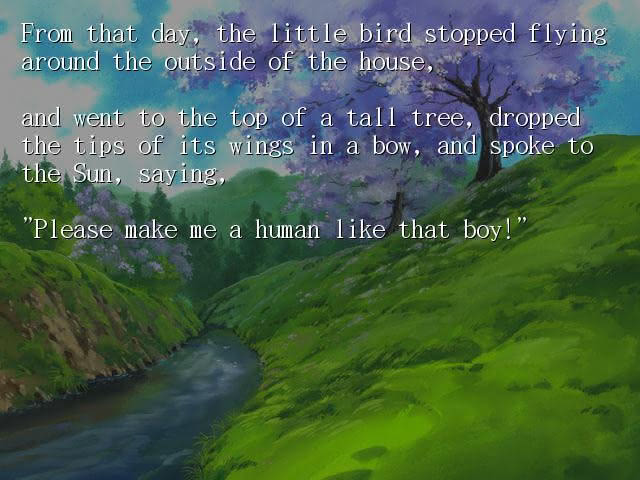
The poor little bird pleaded to be turned into a boy. The Sun, which is a character in this story, pitied the little bird and asked god whether it was possible to turn the poor little bird into a boy. God told the Sun that there was a certain golden fruit that could turn a bird into a boy. The Sun reported this information to the poor little bird.
Searching and Death
The poor little bird searched far and wide for the golden fruit that would make him a boy. His fellow birds told him to give up the hunt, noting that he was working itself to death and that it would never see the boy again. Eventually the bird died from exhaustion while searching for the fruit.
Reuniting the Poor Little Bird With the Boy
The Sun cried, and its tears turned into drops of gold. The Sun was angry that god had done nothing for the little bird, despite its trying so hard. However, god told the Sun to look at the body of the poor little bird. The bird had begun to glow, awash in the Sun’s golden tears. God informed the Sun that the poor little bird had found the golden fruit.
The poor little bird’s body faded away. It was led to heaven by god. In heaven, the bird’s body turned into that of a human being. There, the bird, now a boy, met the boy he had missed so much. The boy smiled at the bird (now a boy), and the bird wept with joy.
It was said long after that a tree grew on the spot where the poor little bird fell and died. In autumn, the tree grew golden fruit.
My Thoughts on the Story (More spoilers)
(Story Spoilers in this section.)

In seeking to understand literature of any form, one should first ascertain the meaning of the author. Only after ascertaining the meaning of the author should one consider their own view of the author’s meaning. So said John Ruskin in his Sesame lecture. He was correct.
In the afterword, the creator, Eno, asked the following question:
Did the little bird find happiness? After it lost its life and saw the boy again, was it happy?
Eno
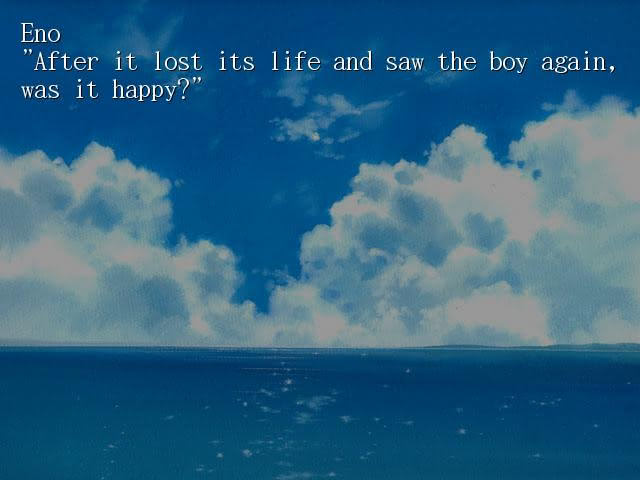
The bird found its happiness in the end. The bird was only happy in its little life when it was with the boy. After the boy died, the bird was distraught. Not only was the bird lonely, but it also came to a misunderstanding that the boy had abandoned it. Deprived of its companion and its sense of self-worth, the bird desperately sought out the boy to understand why the boy had abandoned it – not receptive to signs that the boy had not abandoned it. It was from this misapprehension that the bird’s desire to become a boy was born.
In the end, the bird achieved all of its ends. The bird was willing to exhaust itself to the point of death to meet the boy and discover why the boy had abandoned it. In the end, after death, the bird transmogrified into a boy in heaven, met the boy again, and learned that the boy still loved it and had never abandoned it in the first place. The bird wept with joy because it was not only reunited with the boy but also found that the boy had loved it the whole time.
Having answered Eno’s question for readers, I move on to discuss some of my issues with the story and how it concluded.
Conveniences
The bird suffered greatly in searching for the boy before it died. Its desperate search was not premised solely on its loneliness, but also on a misunderstanding: the assumption that the boy had abandoned it. We are told that the poor little bird did not only want to see the boy again to ameliorate its loneliness, but also to understand why the boy had abandoned it.
Of course, the bird had not been abandoned by the boy at all. One issue I had with the story was that despite the fact that it portrayed the bird as being generally intelligent, we were required to accept that it could not comprehend clear signs that the boy had loved it as a bird. One may come away with the impression that the bird’s desire to become human eventually overtook its desire to understand what had happened to the boy.
Finally, neither the Sun nor the story’s god considered the possibility that the bird’s desire to become a boy, rather than to live out its little bird life in a healthy bird way, was based on a misunderstanding. Why would the Sun and the game’s wise god have believed that the bird needed to become a boy to see the boy again? The story not only declined to confront the bird’s misunderstanding, which caused the bird to reject its nature as a bird, but also seemingly endorsed the bird’s misunderstanding in the conclusion. It would have been possible to give the bird its happy ending for its love of the boy while also giving the story a clearer moral message.
An Interesting Take From the Translator
In the afterword, the translator, Mr. Edward Keyes, offered some thoughts on the game. He jokingly (or perhaps half-jokingly) suggested that the moral of the story was as follows:
…Always get the full story before you leave on your epic quest.
He also suggested:
If someone tells you that you’re on a fool’s errand, maybe you should listen to them.

Mr. Keyes followed that up with a joke about being unduly cynical. However, that modesty is unnecessary. I generally agree with his opinion.
The Morals of the Story
That the bird reached a happy ending does not mean that we have to accept that its path there was the right one.
Mr. Keyes is correct in noting that had the bird listened to those around it, it would have lived out its bird life in a better way. The bird could have lived out its days knowing it was loved by the boy and hoping to reunite with the boy once its time on Earth was done. In so doing, the bird would have not rejected that it was a bird.
In light of the fact that The Poor Little Bird was written to be a sad story, I have no issue with the fact of the bird’s misunderstanding and death themselves (my issues are with how they were explained). Moreover, I have no issue with the bird earning its happy ending for its good heart and devotion to the boy. I do wish, however, that The Poor Little Bird had addressed the bird’s misunderstanding and clarified the moral message of the story. That is, the bird should have understood the important things, but it nevertheless earned its happy ending for its love and courage, however misguided its assumptions had been. The story could have offered the message suggested by Keyes in conjunction with a message that love and loyalty can be rewarded.
The most charitable reading of The Poor Little Bird is that the bird was ultimately saved for its devotion to the boy. That is, while its suffering derived from a misunderstanding about why the boy had left, that misunderstanding came from its sorrow about losing the boy.
However, even if we do not find that the bird’s misunderstanding was necessary for its being reunited with the boy, it was likely necessary for it to become a boy in heaven. The importance of that may be left up to the reader. As I noted, I personally had some difficulty with the story coming close to endorsing the bird’s rejection of the thing about it that the boy very much loved.
Final assessment
That I felt compelled to write a small critique of The Poor Little Bird is, in and of itself, a sign that I found enough value in Eno’s work to carefully consider its message. While I think that the work ultimately had shortcomings when read critically, it was, as I noted in my spoiler-free conclusion above, a piece with heart — and just a bit touching. With certain qualifications, I recommend The Poor Little Bird as a short piece warranting the short time it takes to read and consider.